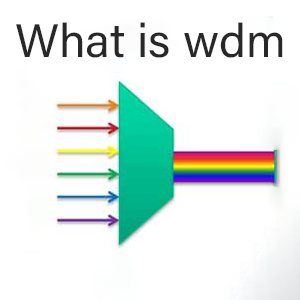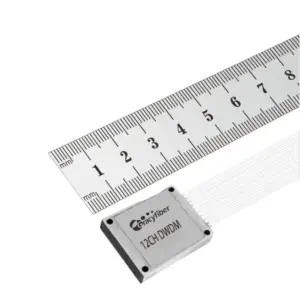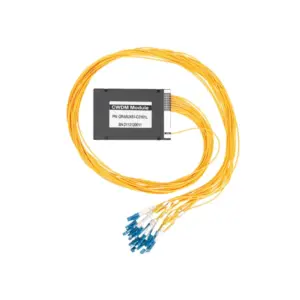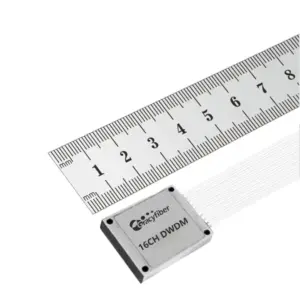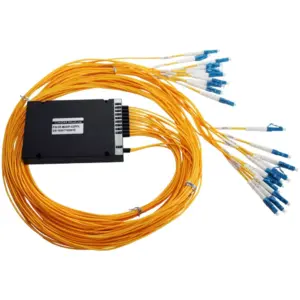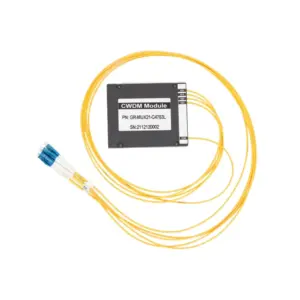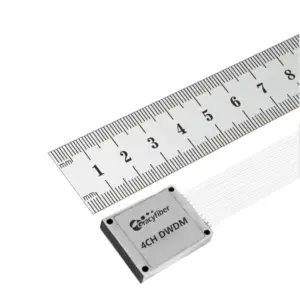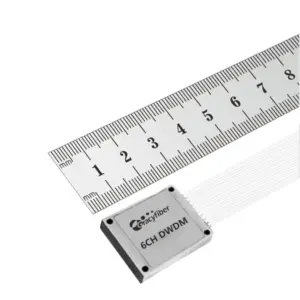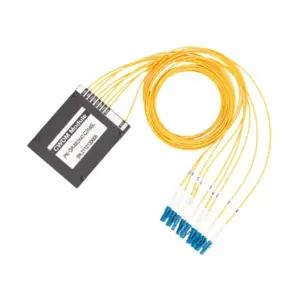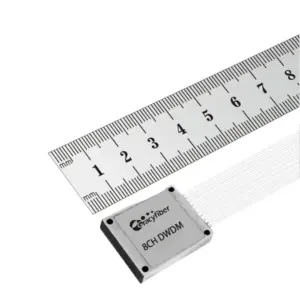WDM technology undoubtedly plays an important role in optical fiber communication networks. This article will focus on the characteristics and applications of WDM technology. We will first define the working principle and core concepts of WDM technology and explain how it realizes multi-channel transmission on optical fiber. Next, we will analyze the advantages of WDM in terms of bandwidth utilization, transmission rate, etc., and explain its improvement in network flexibility and scalability.
We will introduce common types of WDM technology, such as CWDM, DWDM, etc., and compare the differences in technical parameters and application scenarios of different methods. In addition, we will explain the key components required for WDM systems, such as wavelength division multiplexers, and analyze the important functions of various components in the network. Finally, we will list the typical applications of WDM in backbone networks, metropolitan area networks, and access networks, and explain how it improves transmission capabilities in different network layers.

Basic principles of WDM technology
Let me introduce you to the basic principles and working mechanisms of WDM (wavelength division multiplexing) technology.
Working principle of WDM technology:
(1) Definition:
- WDM (Wavelength Division Multiplexing) is a fiber optic communication technology.
- It uses optical signals of different wavelengths to achieve multi-channel transmission on the same optical fiber.
(2) Core concept:
- The core idea of ??WDM technology is to use the broadband characteristics of optical fiber to multiplex optical signals of different wavelengths onto the same optical fiber.
- By multiplexing optical signals of different wavelengths at the transmitting end, they are separated at the receiving end.
Working mechanism of WDM technology:
(1) Wavelength multiplexing:
- At the transmitting end, a wavelength division multiplexer (MUX) is used to combine optical signals of different wavelengths on a single optical fiber for transmission.
- Each channel uses a different carrier wavelength to avoid mutual interference.
(2) Wavelength separation:
- At the receiving end, a wavelength division demultiplexer (DEMUX) is used to separate the multiplexed optical signals.
- The optical signals of different wavelengths are assigned to the corresponding receivers for demodulation.
(3) Fiber transmission:
- The optical signal after wavelength division multiplexing is transmitted over long distances through single-mode optical fiber.
- The broadband characteristics of optical fiber are used to achieve simultaneous transmission of multiple channels.
(4) Wavelength multiplexing technology:
- WDM technology mainly includes CWDM (coarse wavelength division multiplexing) and DWDM (dense WDM).
- DWDM can make more intensive use of the wavelength bandwidth of optical fiber and provide more transmission channels.
In short, WDM technology realizes multi-channel high-speed transmission on the same optical fiber by multiplexing and separating optical signals of different wavelengths. This technology greatly improves the transmission capacity and efficiency of optical fiber communication systems and is one of the key supporting technologies for the development of optical fiber networks.
Main features of WDM technology
Let me introduce you to the main features and advantages of WDM (wavelength division multiplexing) technology in detail.
Advantages of WDM technology in bandwidth utilization and transmission rate:
(1) High bandwidth utilization efficiency:
- WDM can make full use of the bandwidth resources of optical fiber and realize multi-channel transmission on a single optical fiber.
- Compared with single wavelength transmission, WDM can greatly improve the bandwidth utilization of optical fiber.
(2) Significantly improved transmission rate:
- Each WDM channel can reach a transmission rate of Gbps.
- The total bandwidth of multiple WDM channels can easily reach Tbps, meeting future network needs.
(3) The number of channels continues to increase:
- DWDM technology can achieve dense wavelength division multiplexing of up to 80-160 channels.
- With technological advances, the number of WDM channels will continue to increase, and the bandwidth capacity will become larger and larger.
WDM technology improves network flexibility and scalability:
(1) Flexible network expansion:
- When expansion is needed, just add new WDM channels at the transmitter and receiver.
- No need to rewire or replace optical fiber, network bandwidth can be expanded quickly.
(2) Flexible scheduling of network resources:
- Using WDM technology, the bandwidth of each channel can be flexibly allocated and adjusted according to business needs.
- The utilization efficiency of network resources is improved and the overall response capability is enhanced.
(3) Strong network fault tolerance:
- Each WDM channel on a single optical fiber is independent of each other, and the failure of one channel will not affect other channels.
- The reliability and fault tolerance of the network are greatly improved, and the overall availability of the network is enhanced.
In short, WDM technology not only greatly improves bandwidth utilization and transmission rate by realizing multi-channel high-speed transmission on a single optical fiber, but also brings huge advantages for flexible expansion and resource scheduling of the network. This makes WDM one of the key technologies for the development of future high-speed optical fiber networks.
Main types of WDM technology
Let me introduce you to several common types of WDM technology and compare their differences in technical parameters and application scenarios.
Main types of WDM technology:
(1) CWDM (Coarse Wavelength Division Multiplexing):
- CWDM uses 8 standard wavelength channels with a larger wavelength interval (20nm).
- The wavelength range is between 1271nm and 1611nm, and the number of channels is small.
(2) DWDM (Dense Wavelength Division Multiplexing):
- DWDM uses 40~80 standard wavelength channels with a smaller wavelength interval (0.8nm or 0.4nm).
- The wavelength range is C-band (1530nm-1565nm) or L-band (1565nm-1625nm).
(3) TWDM (Time Division Wavelength Division Multiplexing):
- TWDM combines time division multiplexing (TDM) and wavelength division multiplexing (WDM) technologies.
- Time division multiplexing is used on the same wavelength channel to further increase the single-fiber transmission capacity.
(4) NG-PON2 (Next Generation Passive Optical Network):
- NG-PON2 uses TWDM technology and uses TDM multiplexing on 4 wavelength channels.
- With a total bandwidth of up to 10Gbps, it is suitable for the next generation fiber-to-the-home (FTTH) network.
Comparison of different WDM technologies:
(1) Technical parameter comparison:
- CWDM has fewer channels and larger single-channel bandwidth; DWDM has more channels and higher bandwidth.
- TWDM and NG-PON2 combine time division and wavelength division to achieve higher total bandwidth.
(2) Differences in application scenarios:
- CWDM is suitable for medium-distance metro networks and access network scenarios.
- DWDM is mainly used for trunk networks and long-distance backbone transmission.
- TWDM and NG-PON2 are aimed at future fiber-to-the-home (FTTH) networks.
(3) Comparison of cost and complexity:
- CWDM is more economical than DWDM, but has fewer channels.
- DWDM devices and modulation technology are more complex, and the deployment cost is higher.
- TWDM and NG-PON2 use existing TWDM-PON equipment, and the deployment cost is lower.
In short, different types of WDM technologies have certain differences in technical parameters, cost, complexity, etc. for different application scenarios and needs. Network builders need to weigh and choose the most appropriate WDM method based on actual needs.
The role of WDM devices and components
Let me introduce in detail the key devices required in the WDM system and their important functions in the entire network.
Key components of WDM system:
(1) Wavelength Division Multiplexer (Multiplexer, Mux):
- Used to multiplex optical signals of different wavelengths onto the same optical fiber for transmission.
- Merge multiple optical signals into one optical fiber at the transmitting end.
(2) Wavelength Division Demultiplexer (Demultiplexer, Demux):
- Used to separate optical signals of different wavelengths multiplexed on the same optical fiber.
- Distribute optical signals to corresponding receiving devices at the receiving end.
(3) Optical Circulator:
- Used to realize bidirectional transmission of optical signals on a single optical fiber.
- Can separate the optical signal paths at the transmitting end and the receiving end.
(4) Optical Amplifier:
- Amplifies WDM signals to compensate for attenuation during optical fiber transmission.
- Ensures that WDM systems can achieve long-distance transmission.
(5) Optical Coupler:
- Used to couple or separate two optical signals and adjust optical power.
- Used to distribute or combine optical signals in WDM systems.
Important functions of various devices in WDM networks:
(1) Multiplexing and separation functions:
- Mux and Demux are the core of WDM systems, realizing the multiplexing and separation of multiple wavelength channels.
- Ensures that the optical signals of each channel can be transmitted independently on the same optical fiber.
(2) Bidirectional transmission support:
- The optical loop isolator enables the optical signals at the transmitting and receiving ends to be transmitted bidirectionally on the same optical fiber.
- It avoids the interference of optical signals between the transmitting and receiving ends.
(3) Signal amplification function:
- The optical amplifier can compensate for the attenuation during optical fiber transmission and extend the transmission distance of the optical signal.
- It ensures that the WDM system can stably and reliably transmit multiple optical signals over long distances.
(4) Optical power regulation:
- The optical coupler is used to adjust the power ratio of optical signals of different wavelengths to ensure the performance balance of each channel.
- It optimizes the overall performance and transmission stability of the WDM system.
In short, these key components together constitute the hardware foundation of the WDM system and provide the necessary physical support for realizing multi-channel optical transmission. They play a vital role in multiplexing and separation, bidirectional transmission, signal amplification and power regulation.
Application of WDM technology in optical fiber networks
Let me summarize for you the typical application scenarios of WDM technology at various levels of optical fiber networks and how it improves the transmission capacity of these network layers.
Application of WDM technology at different network levels:
(1) Backbone network layer:
- WDM technology is widely used in long-distance optical fiber backbone networks.
- Using DWDM to achieve up to 80-160 wavelength channels, greatly improving the total transmission bandwidth.
(2) Metropolitan Area Network Layer:
- WDM is also widely used in metropolitan area networks, especially CWDM technology.
- High-speed transmission is achieved in medium-distance metropolitan area networks through 8 wavelength channels.
(3) Access Network Layer:
- In the access network of fiber to the home (FTTH), TWDM-PON technologies such as NG-PON2 are used.
- Time division multiplexing and wavelength division multiplexing are used on a single optical fiber to provide users with high-speed access.
How does WDM improve the transmission capacity of different network layers:
(1) Backbone Network Layer:
- The high channel density and transmission rate of DWDM have greatly improved the overall bandwidth of the backbone network.
- It meets the growing demand for broadband services and data at home and abroadThe demand for central interconnection.
(2) Metropolitan area network layer:
- CWDM achieves medium-distance transmission through 8 relatively widely spaced wavelengths.
- It greatly improves the transmission capacity of the metropolitan area network and meets the needs of the metro network.
(3) Access network layer:
- The application of TWDM-PON technologies such as NG-PON2 in the access network provides users with access bandwidth of up to 10Gbps.
- It meets the needs of future families and enterprises for high-speed broadband access.
In summary, WDM technology plays an important role at different network levels. It provides ultra-high-speed transmission capabilities in the backbone network, realizes medium-distance high-bandwidth transmission in the metropolitan area network, and supports future ultra-high-speed fiber-to-the-home applications in the access network. WDM technology is one of the key technologies supporting the development of the next generation of high-speed optical networks.
Summary
WDM technology is undoubtedly the key to building a high-performance optical fiber network. Our company has long been focusing on the research and development and application of optical communication technology and has rich industry experience. Our WDM system products have reached the industry-leading level in terms of optical performance and reliability, and can meet your demanding needs for network bandwidth expansion.
Whether you need to deploy in a long-distance backbone network, metropolitan area network environment, or in a short-distance access network scenario, we can provide you with customized WDM solutions. At the same time, our professional team will provide you with a full range of technical support, including solution design, on-site guidance, and daily maintenance suggestions. Contact us now to learn more about WDM technology.
Wavelength Division Multiplexing FAQ
WDM is a technology that multiplexes multiple optical carrier signals on a single optical fiber by using different wavelengths (or colors) of laser light.
The two main types are Coarse WDM (CWDM) and Dense WDM (DWDM), which differ in the number of wavelength channels and channel spacing.
WDM allows for significantly increased bandwidth and data transmission capacity over a single fiber, improving efficiency and cost-effectiveness.
CWDM systems typically use wavelengths between 1271 nm and 1611 nm, while DWDM systems use wavelengths in the C-band (1530 nm to 1565 nm) and L-band (1565 nm to 1625 nm).
By transmitting multiple data streams on different wavelengths, WDM can multiply the effective capacity of a single fiber, often by a factor of 4, 8, or even more.
Essential components include optical multiplexers, demultiplexers, optical amplifiers, and wavelength-specific optical transceivers.
WDM is widely used in long-haul telecommunications, data center interconnections, and metropolitan area networks to increase fiber optic network capacity.
WDM systems often incorporate dispersion compensation and optical amplification to maintain signal quality over long transmission distances.
Challenges include maintaining precise wavelength control, managing thermal effects, and ensuring compatibility between different WDM components.
Ongoing advancements include the use of higher-density DWDM, the integration of WDM with other optical technologies, and the development of tunable and reconfigurable WDM systems.

